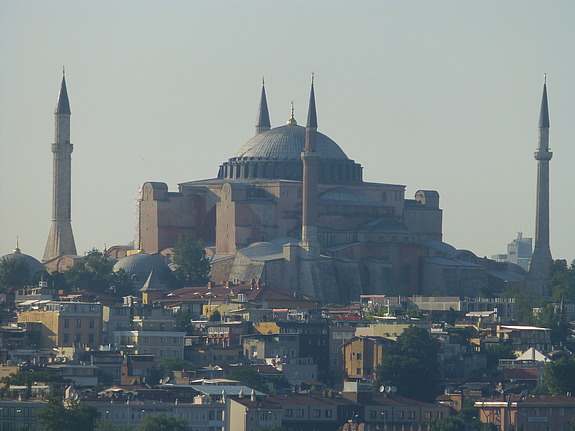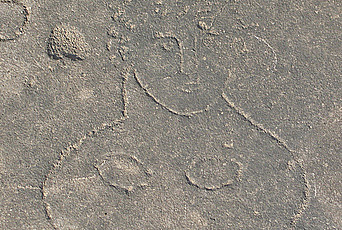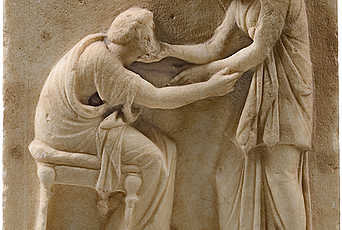The conversion of Hagia Sophia, then the greatest church of Christianity, into a mosque in 1453 by Mehmet the Conqueror was not a historical paradox. Over the centuries, places of worship often passed from one religious community to another, hosting new gods or losing their sacred character altogether. In ancient polytheism, the conversion of a sanctuary was rarely violent—the conversion of the Temple in Jerusalem into a shrine of Zeus by Antiochus IV is the exception. Usually, the old god was associated with the new one. The pre-Greek god Welchanos became Zeus Welchanios, the Persian Anahita was worshiped as Artemis Anaitis. Monotheistic religions that came into conflict with other religions have proven less tolerant. With the recognition of Christianity as the official religion of the Roman Empire, hundreds of shrines were destroyed, converted to Christian temples, or abandoned. In Athens, the Parthenon became a church of Virgin Mary, the Pantheon in Rome a church of the Virgin and the Martyrs. The Arab and later the Ottoman conquests had similar results for countless Christian churches that were converted into mosques. If the conversion of Hagia Sophia into a mosque in 1453 was not a paradox, Kemal Atatürk’s decision to turn the mosque of Ayasofya into a museum in 1934 was. The founder of the modern Turkish state intended to create a symbol for a new secular Turkey.
The decision of President Erdoğan to turn Hagia Sophia into a mosque again was expected and corresponds to his policies and methods. The more he defies the Western world, the greater the support of the electorate. He can expect that the criticism will subside soon; a museum can easily be sacrificed for the sake of political, strategic, and economic interests.
The special importance of Hagia Sophia for Greeks and Orthodox Christians cannot easily be understood by others. In psychology, the term “ambiguous loss” describes someone’s pain when a person close to them is both present and absent—e.g., physically present but mentally absent (a parent with dementia) or physically absent and psychologically present (e.g., a divorced partner). For the Greeks, Hagia Sophia has been such an ambiguous loss for centuries. An expression of the brilliance of the Byzantine past and a symbol of Orthodoxy, this monument is present in their collective consciousness, but at the same time its dominant presence in Istanbul constantly reminds them of the shattered vision of the “Great Idea” (Megáli Idéa), the dream of incorporating Istanbul/Constantinople into a Greek state. But for the last 85 years, Hagia Sophia could at least be visited as a museum, a place of remembrance and aesthetic appreciation. The ambiguous loss had left a scar that sometimes hurt. The conversion of Hagia Sophia from a museum into a mosque turns the scar into an open wound.
The Greeks and the Orthodox Christians were not the only targets of the Turkish President. Perhaps his most important motivation was to send a message to those Turks who remain committed to the Kemalist idea of a secular Turkey, proud of its traditions and culture, but open to a dialogue with other cultures. As Orhan Pamuk, the Turkish Nobel laurate in literature, put it: “to convert it [Hagia Sophia] back to a mosque is to say to the rest of the world, unfortunately we are not secular anymore.” Now the millions of secular Turks will also feel the ambiguous loss of Hagia Sophia. In the city that most vehemently rejects Erdoğan’s policy, Hagia Sophia will be visibly present and at the same time absent as a symbol of a secular Turkey.
If for Greeks, Orthodox Christians, and secular Turks Hagia Sophia represents an ambiguous loss, for the United Nations Educational, Scientific, and Cultural Organization (UNESCO) it is a direct blow. UNESCO has recognized Hagia Sophia as a World Heritage Monument because of its significance as a symbol of cultural exchanges between Europe and Asia. The combination of Christian and Islamic elements—mosaics and minarets—made the successive layers of history visible. The conversion of a museum into a site of worship is unprecedented; and for the first time a member state of UNESCO has unilaterally changed the status of a World Heritage Site. Although Turkey’s decision is a direct violation of the 1972 UNESCO Convention, UNESCO’s reaction has been mild. The Director General expressed her deep sorrow and urged Turkey to enter into a dialogue for measures to be taken to protect the monument and the works of art. That’s all.
President Erdoğan’s decision teaches us nothing that we did not already know about his methods. But the way UNESCO will handle this matter will certainly teach us something about its seriousness, effectiveness, and sense of responsibility. UNESCO is in danger of losing its reputation, not ambiguously, but very clearly.


